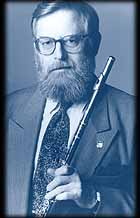
|
|
|
|
|
|
|
Lew Tabackin
Lew Tabackin draws upon a wide range of influences to arrive at a very personal expression through his music. On the flute, he combines western classical influences with the gentle spirit of the orient. He’s also recognized for his smooth and energetic style on the tenor saxophone. A spirited audience at the Kennedy Center’s Terrace Theater greets Tabackin with resounding applause, as he opens the show with his own composition, "Chasing the Carrot". Tabackin grew up in Philadelphia, where he learned both flute and saxophone. He first studied flute, but was eager to pick up tenor sax when he started listening to jazz. Tabackin says Philly was a good town in which to learn jazz, because beginners were "tolerated", and he was able to get into jam sessions as a teenager and play with more experienced players. In 1965, Tabackin moved to New York "with four hundred bucks" in his pocket to pursue his career in jazz. He played in jam sessions while trying to get work, and ended up on sax with Cab Calloway’s big band, a highlight of his early career. At twenty-five, Tabackin welcomed being in the presence of great musicians, like Eddie Barefield and Doc Cheatham, who he says were like mentors to him. Tabackin also played in other notable bands, including those of Duke Pearson, Thad Jones, Mel Lewis, and Clark Terry. He credits much of his early development to being in the New York scene, with its intensity and competitive spirit. Tabackin’s influences go well beyond the giants of jazz. His flute playing incorporates both an eastern European and a Japanese influences. In New York, Tabackin had worked with Japanese jazz pianist Toshiko Akiyoshi, whom he eventually married. Toshiko’s compositions are recognized for integrating the Japanese tradition within a western context. According to Tabackin, "[Toshiko] feels strongly about trying to give something of her tradition, instead of just taking out of the jazz tradition". This has posed a challenge to Tabackin, who has been a primary soloist on many of these compositions in Akiyoshi's big bands. In some cases, traditional jazz techniques did not seem appropriate. Tabackin has studied Japanese methods on flute, taking a sort of "Zen approach", he says. In the process, he has also observed common elements between American jazz and traditional Japanese music. His understanding and appreciation of both traditions comes across clearly in his powerful flute rendition of John Coltrane’s "Wise One". Dr. Taylor and Tabackin discuss tenor saxophonists who influenced his own development on sax. Tabackin cites Sonny Rollins and Coltrane as major influences, among others. By the age of twenty, Tabackin was trying to imitate Coltrane when he realized it was more important to develop his own voice as a musician. As he matured, he learned to listen to a variety of music, absorb the diverse elements, and let them "come out in their own way" through his playing. Dr. Taylor notes that ballads and rhythmic pieces draw out a musician’s
individuality. This point is made evident when Tabackin does a soul-stirring rendition
of "You Don’t Know What Love Is" on tenor sax. Billy prompts Tabackin to demonstrate his
unique approach to rhythm with his own variation on George Gershwin’s "I Got Rhythm".
Tabackin and Billy’s trio close out the show with "I’ll Be Seeing You".
|
|
| |
